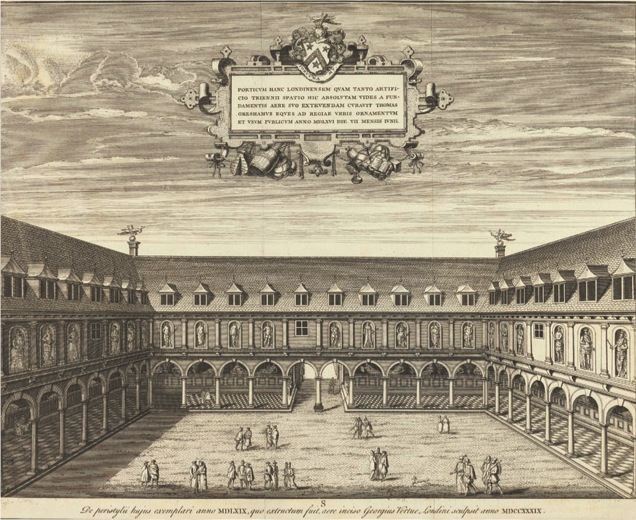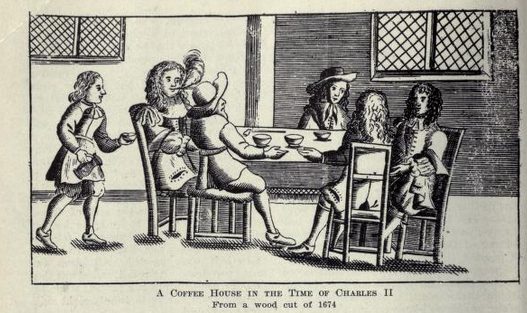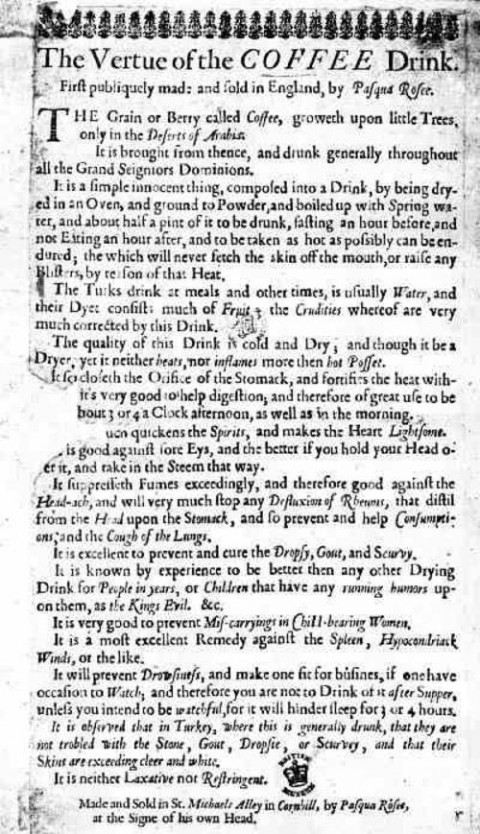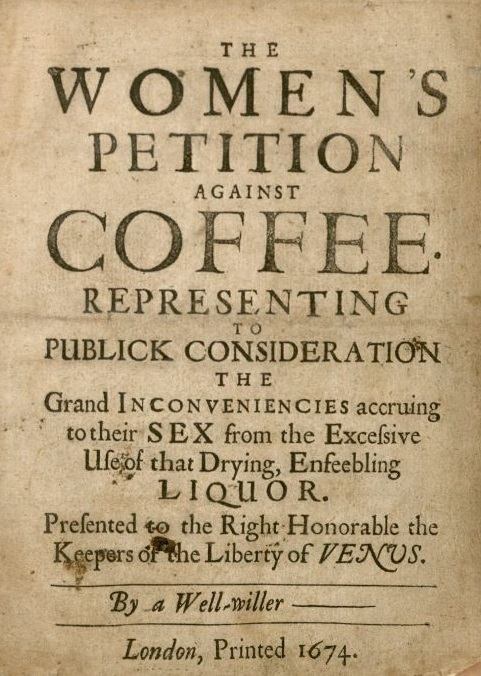In the 1650s, London welcomed its first cafe serving coffee. The place was St. Michael’s Alley on London’s Cornhill, and its owner, Greek-Sicilian immigrant Pasqua Rosée, helped introduce the gin-soaked British to the drink that would become a culinary mainstay.
It wasn’t much of a coffee shop by today’s terms. There were no baristas to write your name on a thick-lipped beaker lest your chewy flat white, decaf with soya get confused with another patron’s actual cup of coffee – the 21st Century trend is for an insipid Americanised brew one British reviewer likened to “a pale, scalding version of junior-school, jam-jar brush water”. Pasqua’s place was a stall severing coffee one way: “black as hell, strong as death, sweet as love.”
Pasqua had picked his site well. In December 1912, London Review looked back at the area, focusing on the nearby Royal Exchange:
“Here one may meet persons assembled from all parts of the universe, either to procure bills of exchange, to hire shipping, to learn news of the army, or the sailing of any particular vessel: in short, at London is known every thing that passes on the sea, and almost in all parts of the world to which they trade; for it must be allowed, that the English well understand the maritime art, and that they are true merchants on all seas with marvellous success and profit.”
(The cafe is at St Michael’s Alley, Cornhill, London EC3 is now The Jamaica Wine House – which sounds rather grand but is in reality a pub.)
The exotic sold the exotic. And we should thank Daniel Edwards, a merchant with the Levant Company. He’d returned to London from Turkey, bringing with him Pasqua Rosée, his unfamiliar looking servant.
Tsiosophy adds:
Rosée capitalized on his foreign moniker and striking Greco-Turkish features to hawk his drink and to spawn a style of naming coffee houses with a Middle Eastern ring…
The ale taverns in the neighborhood complained and scapegoated the prospering foreigner for their loss of business. Rosée was forced to partner with the freeman and grocer Christopher Bowman who later moved the service in 1656 to a house across the way in St. Michael’s Alley to expanded space, patronage, and profits. Soon after, Rosée left, but Bowman continued to serve customers under his sign – a hand pouring coffee from a pot into a cup – in a “Coffee Room…up one pair of stairs” until his death in 1662. The widow Bowman kept the place, and Bowman’s apprentices waited on patrons until 1665 when new management took over the shop, freshly styled the “Ould Coffee House,” which within a year burned in the Great Fire.
The cafe produced an advert. Punters were advised how to take the exotic drink from the Orient. As ever – what with this being about food and drink advertising – coffee was sold as a health substance to be taken twice a day. It was not organic, radiated, fair trade, unfair trade or passed by virgin otters, but given Pasqua’s flair of marketing it could have been had he thought anyone wanted it.
The Advert:
THE Grain or Berry called Coffee, groweth upon little Trees, only in the Deserts of Arabia.
It is brought from thence, and drunk generally throughout all the Grand Seigniors Dominions.
It is a simple innocent thing, composed into a drink, by being dryed in an Oven, and ground to Powder, and boiled up with Spring water, and about half a pint of it to be drunk, fasting an hour before and not Eating an hour after, and to be taken as hot as possibly can be endured; the which will never fetch the skin off the mouth, or raise any Blisters, by reason of that Heat.
The Turks drink at meals and other times, is usually Water, and their Dyet consists much of Fruit, the Crudities whereof are very much corrected by this Drink.
The quality of this Drink is cold and Dry; and though it be a Dryer, yet it neither heats, nor inflames more than hot Posset.
It forcloseth the Orifice of the Stomack, and fortifies the heat with- [missing text] its very good to help digestion, and therefore of great use to be [missing text] bout 3 or 4 a Clock afternoon, as well as in the morning.
[missing text] quickens the Spirits, and makes the Heart Lightsome.
[missing text]is good against sore Eys, and the better if you hold your Head o’er it, and take in the Steem that way.
It supresseth Fumes exceedingly, and therefore good against the Head-ach, and will very much stop any Defluxion of Rheumas, that distil from the Head upon the Stomach, and so prevent and help Consumptionsand the Cough of the Lungs.
It is excellent to prevent and cure the Dropsy, Gout, and Scurvy.
It is known by experience to be better then any other Drying Drink for People in years, or Children that have any running humors upon them, as the Kings Evil. &c.
It is very good to prevent Mis-carryings in Child-bearing Women.It is a most excellent Remedy against the Spleen, Hypocondriack Winds, or the like.
It will prevent Drowsiness, and make one fit for Busines, if one have occasion to Watch, and therefore you are not to drink of it after Supper, unless you intend to be watchful, for it will hinder sleep for 3 or 4 hours.It is observed that in Turkey, where this is generally drunk, that they are not troubled with the Stone, Gout, Dropsie, or Scurvy, and that their Skins are exceeding cleer and white.
It is neither Laxative nor Restringent.
Made and Sold in St. Michaels Alley in Cornhill, by Pasqua Rosee, at the Signe of his own Head.
Of course, as with all advertising, the magick didn’t work for everyone:
Via: Vintage Ads, BoingBoing, London Historians
Would you like to support Flashbak?
Please consider making a donation to our site. We don't want to rely on ads to bring you the best of visual culture. You can also support us by signing up to our Mailing List. And you can also follow us on Facebook, Instagram and Twitter. For great art and culture delivered to your door, visit our shop.






